Zhouhan Lin
FlowRL: Matching Reward Distributions for LLM Reasoning
Sep 18, 2025Abstract:We propose FlowRL: matching the full reward distribution via flow balancing instead of maximizing rewards in large language model (LLM) reinforcement learning (RL). Recent advanced reasoning models adopt reward-maximizing methods (\eg, PPO and GRPO), which tend to over-optimize dominant reward signals while neglecting less frequent but valid reasoning paths, thus reducing diversity. In contrast, we transform scalar rewards into a normalized target distribution using a learnable partition function, and then minimize the reverse KL divergence between the policy and the target distribution. We implement this idea as a flow-balanced optimization method that promotes diverse exploration and generalizable reasoning trajectories. We conduct experiments on math and code reasoning tasks: FlowRL achieves a significant average improvement of $10.0\%$ over GRPO and $5.1\%$ over PPO on math benchmarks, and performs consistently better on code reasoning tasks. These results highlight reward distribution-matching as a key step toward efficient exploration and diverse reasoning in LLM reinforcement learning.
Pretraining Language Models to Ponder in Continuous Space
May 27, 2025Abstract:Humans ponder before articulating complex sentence elements, enabling deeper cognitive processing through focused effort. In this work, we introduce this pondering process into language models by repeatedly invoking the forward process within a single token generation step. During pondering, instead of generating an actual token sampled from the prediction distribution, the model ponders by yielding a weighted sum of all token embeddings according to the predicted token distribution. The generated embedding is then fed back as input for another forward pass. We show that the model can learn to ponder in this way through self-supervised learning, without any human annotations. Our method is straightforward and can be seamlessly integrated with various existing language models. Experiments across three widely used open-source architectures-GPT-2, Pythia, and LLaMA-and extensive downstream task evaluations demonstrate the effectiveness and generality of our method. For language modeling tasks, pondering language models achieve performance comparable to vanilla models with twice the number of parameters. On 9 downstream benchmarks, our pondering-enhanced Pythia models significantly outperform the official Pythia models. Notably, pondering-enhanced Pythia-1B is comparable to TinyLlama-1.1B, which is trained on 10 times more data. The code is available at https://github.com/LUMIA-Group/PonderingLM.
FreqKV: Frequency Domain Key-Value Compression for Efficient Context Window Extension
May 01, 2025Abstract:Extending the context window in large language models (LLMs) is essential for applications involving long-form content generation. However, the linear increase in key-value (KV) cache memory requirements and the quadratic complexity of self-attention with respect to sequence length present significant challenges during fine-tuning and inference. Existing methods suffer from performance degradation when extending to longer contexts. In this work, we introduce a novel context extension method that optimizes both fine-tuning and inference efficiency. Our method exploits a key observation: in the frequency domain, the energy distribution of the KV cache is primarily concentrated in low-frequency components. By filtering out the high-frequency components, the KV cache can be effectively compressed with minimal information loss. Building on this insight, we propose an efficient compression technique, FreqKV, that iteratively compresses the increasing KV cache to a fixed size in the frequency domain, applicable to both fine-tuning and inference. FreqKV introduces no additional parameters or architectural modifications. With minimal fine-tuning, LLMs can learn to leverage the limited cache that is compressed in the frequency domain and extend the context window efficiently. Experiments on various long context language modeling and understanding tasks demonstrate the efficiency and efficacy of the proposed method.
Alleviating LLM-based Generative Retrieval Hallucination in Alipay Search
Mar 27, 2025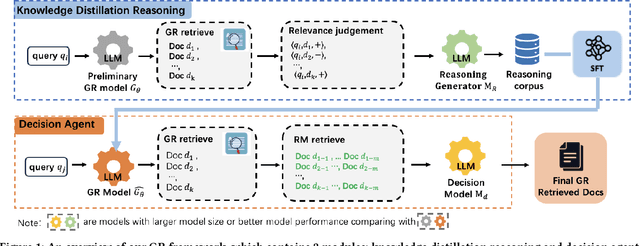
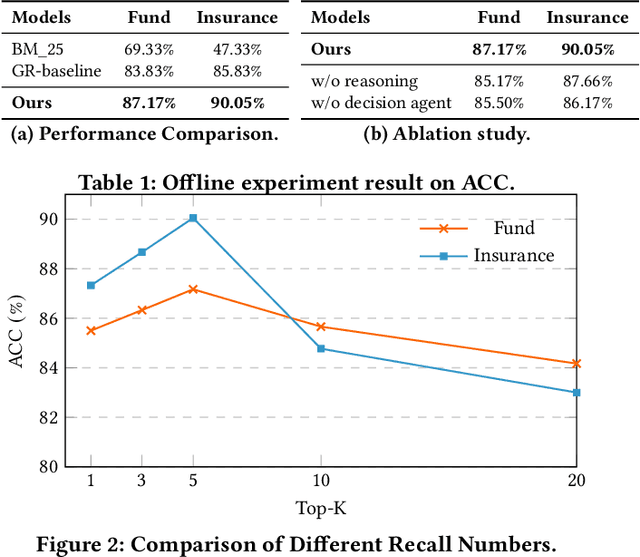

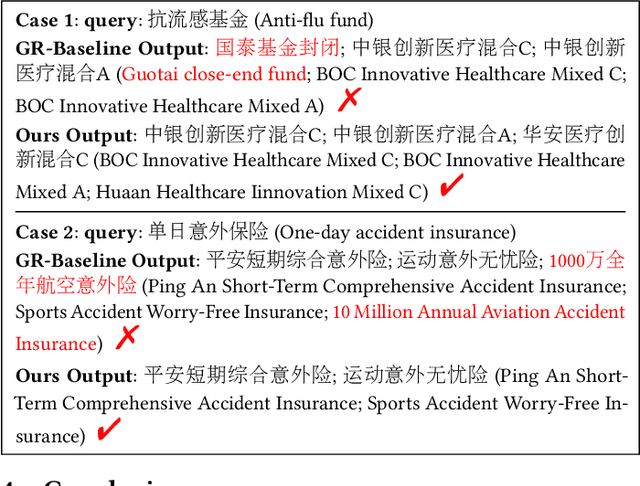
Abstract:Generative retrieval (GR) has revolutionized document retrieval with the advent of large language models (LLMs), and LLM-based GR is gradually being adopted by the industry. Despite its remarkable advantages and potential, LLM-based GR suffers from hallucination and generates documents that are irrelevant to the query in some instances, severely challenging its credibility in practical applications. We thereby propose an optimized GR framework designed to alleviate retrieval hallucination, which integrates knowledge distillation reasoning in model training and incorporate decision agent to further improve retrieval precision. Specifically, we employ LLMs to assess and reason GR retrieved query-document (q-d) pairs, and then distill the reasoning data as transferred knowledge to the GR model. Moreover, we utilize a decision agent as post-processing to extend the GR retrieved documents through retrieval model and select the most relevant ones from multi perspectives as the final generative retrieval result. Extensive offline experiments on real-world datasets and online A/B tests on Fund Search and Insurance Search in Alipay demonstrate our framework's superiority and effectiveness in improving search quality and conversion gains.
DiVISe: Direct Visual-Input Speech Synthesis Preserving Speaker Characteristics And Intelligibility
Mar 07, 2025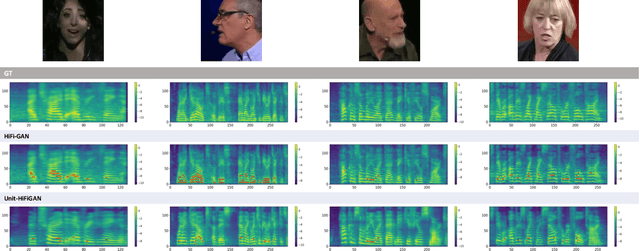


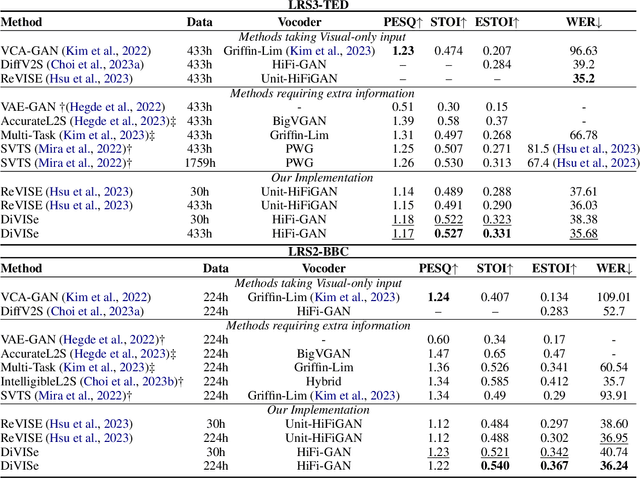
Abstract:Video-to-speech (V2S) synthesis, the task of generating speech directly from silent video input, is inherently more challenging than other speech synthesis tasks due to the need to accurately reconstruct both speech content and speaker characteristics from visual cues alone. Recently, audio-visual pre-training has eliminated the need for additional acoustic hints in V2S, which previous methods often relied on to ensure training convergence. However, even with pre-training, existing methods continue to face challenges in achieving a balance between acoustic intelligibility and the preservation of speaker-specific characteristics. We analyzed this limitation and were motivated to introduce DiVISe (Direct Visual-Input Speech Synthesis), an end-to-end V2S model that predicts Mel-spectrograms directly from video frames alone. Despite not taking any acoustic hints, DiVISe effectively preserves speaker characteristics in the generated audio, and achieves superior performance on both objective and subjective metrics across the LRS2 and LRS3 datasets. Our results demonstrate that DiVISe not only outperforms existing V2S models in acoustic intelligibility but also scales more effectively with increased data and model parameters. Code and weights can be found at https://github.com/PussyCat0700/DiVISe.
AdaptiveStep: Automatically Dividing Reasoning Step through Model Confidence
Feb 19, 2025Abstract:Current approaches for training Process Reward Models (PRMs) often involve breaking down responses into multiple reasoning steps using rule-based techniques, such as using predefined placeholder tokens or setting the reasoning step's length into a fixed size. These approaches overlook the fact that specific words do not typically mark true decision points in a text. To address this, we propose AdaptiveStep, a method that divides reasoning steps based on the model's confidence in predicting the next word. This division method provides more decision-making information at each step, enhancing downstream tasks, such as reward model learning. Moreover, our method does not require manual annotation. We demonstrate its effectiveness through experiments with AdaptiveStep-trained PRMs in mathematical reasoning and code generation tasks. Experimental results indicate that the outcome PRM achieves state-of-the-art Best-of-N performance, surpassing greedy search strategy with token-level value-guided decoding, while also reducing construction costs by over 30% compared to existing open-source PRMs. In addition, we provide a thorough analysis and case study on the PRM's performance, transferability, and generalization capabilities.
How to Synthesize Text Data without Model Collapse?
Dec 19, 2024

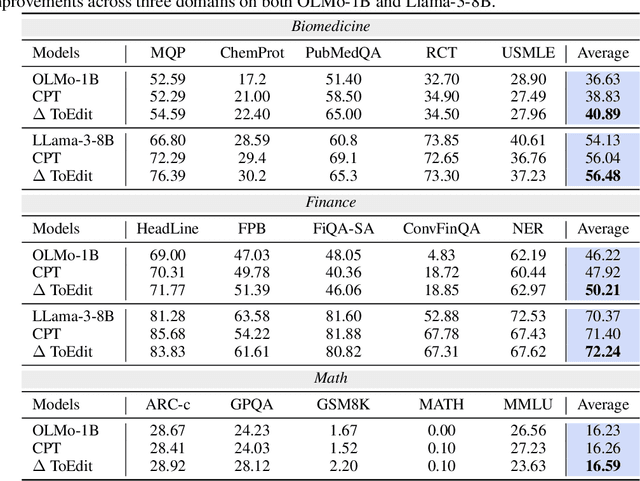
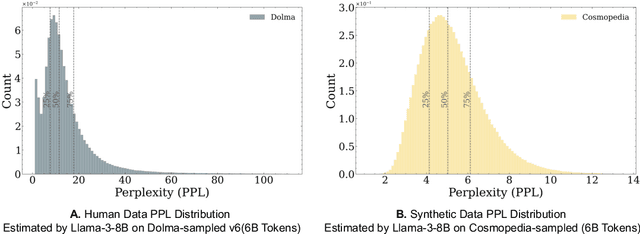
Abstract:Model collapse in synthetic data indicates that iterative training on self-generated data leads to a gradual decline in performance. With the proliferation of AI models, synthetic data will fundamentally reshape the web data ecosystem. Future GPT-$\{n\}$ models will inevitably be trained on a blend of synthetic and human-produced data. In this paper, we focus on two questions: what is the impact of synthetic data on language model training, and how to synthesize data without model collapse? We first pre-train language models across different proportions of synthetic data, revealing a negative correlation between the proportion of synthetic data and model performance. We further conduct statistical analysis on synthetic data to uncover distributional shift phenomenon and over-concentration of n-gram features. Inspired by the above findings, we propose token editing on human-produced data to obtain semi-synthetic data. As a proof of concept, we theoretically demonstrate that token-level editing can prevent model collapse, as the test error is constrained by a finite upper bound. We conduct extensive experiments on pre-training from scratch, continual pre-training, and supervised fine-tuning. The results validate our theoretical proof that token-level editing improves data quality and enhances model performance.
Cluster-wise Graph Transformer with Dual-granularity Kernelized Attention
Oct 09, 2024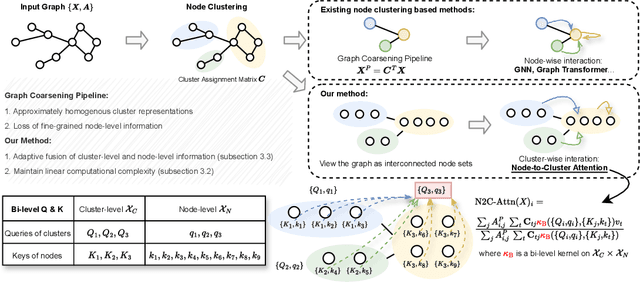
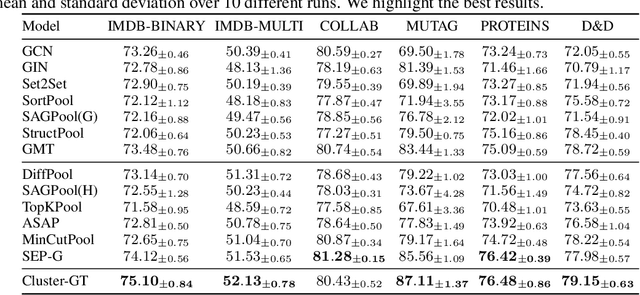

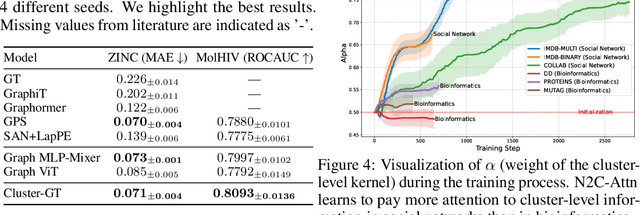
Abstract:In the realm of graph learning, there is a category of methods that conceptualize graphs as hierarchical structures, utilizing node clustering to capture broader structural information. While generally effective, these methods often rely on a fixed graph coarsening routine, leading to overly homogeneous cluster representations and loss of node-level information. In this paper, we envision the graph as a network of interconnected node sets without compressing each cluster into a single embedding. To enable effective information transfer among these node sets, we propose the Node-to-Cluster Attention (N2C-Attn) mechanism. N2C-Attn incorporates techniques from Multiple Kernel Learning into the kernelized attention framework, effectively capturing information at both node and cluster levels. We then devise an efficient form for N2C-Attn using the cluster-wise message-passing framework, achieving linear time complexity. We further analyze how N2C-Attn combines bi-level feature maps of queries and keys, demonstrating its capability to merge dual-granularity information. The resulting architecture, Cluster-wise Graph Transformer (Cluster-GT), which uses node clusters as tokens and employs our proposed N2C-Attn module, shows superior performance on various graph-level tasks. Code is available at https://github.com/LUMIA-Group/Cluster-wise-Graph-Transformer.
Enhancing SPARQL Generation by Triplet-order-sensitive Pre-training
Oct 08, 2024



Abstract:Semantic parsing that translates natural language queries to SPARQL is of great importance for Knowledge Graph Question Answering (KGQA) systems. Although pre-trained language models like T5 have achieved significant success in the Text-to-SPARQL task, their generated outputs still exhibit notable errors specific to the SPARQL language, such as triplet flips. To address this challenge and further improve the performance, we propose an additional pre-training stage with a new objective, Triplet Order Correction (TOC), along with the commonly used Masked Language Modeling (MLM), to collectively enhance the model's sensitivity to triplet order and SPARQL syntax. Our method achieves state-of-the-art performances on three widely-used benchmarks.
Training-free LLM-generated Text Detection by Mining Token Probability Sequences
Oct 08, 2024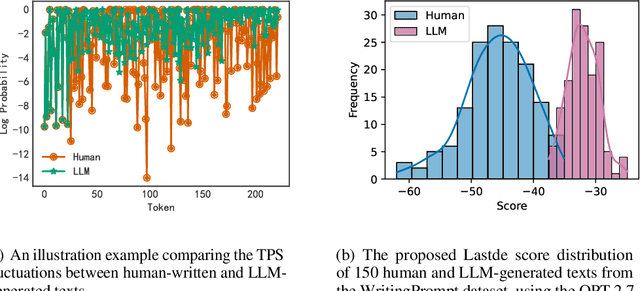

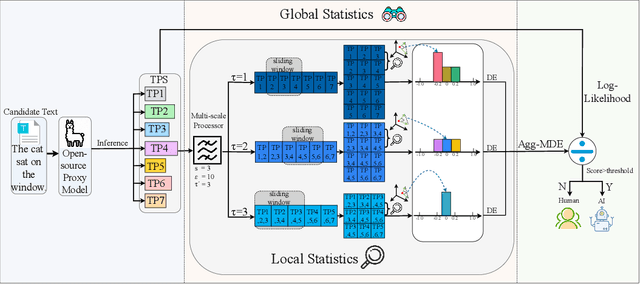

Abstract:Large language models (LLMs) have demonstrated remarkable capabilities in generating high-quality texts across diverse domains. However, the potential misuse of LLMs has raised significant concerns, underscoring the urgent need for reliable detection of LLM-generated texts. Conventional training-based detectors often struggle with generalization, particularly in cross-domain and cross-model scenarios. In contrast, training-free methods, which focus on inherent discrepancies through carefully designed statistical features, offer improved generalization and interpretability. Despite this, existing training-free detection methods typically rely on global text sequence statistics, neglecting the modeling of local discriminative features, thereby limiting their detection efficacy. In this work, we introduce a novel training-free detector, termed \textbf{Lastde} that synergizes local and global statistics for enhanced detection. For the first time, we introduce time series analysis to LLM-generated text detection, capturing the temporal dynamics of token probability sequences. By integrating these local statistics with global ones, our detector reveals significant disparities between human and LLM-generated texts. We also propose an efficient alternative, \textbf{Lastde++} to enable real-time detection. Extensive experiments on six datasets involving cross-domain, cross-model, and cross-lingual detection scenarios, under both white-box and black-box settings, demonstrated that our method consistently achieves state-of-the-art performance. Furthermore, our approach exhibits greater robustness against paraphrasing attacks compared to existing baseline methods.
 Add to Chrome
Add to Chrome Add to Firefox
Add to Firefox Add to Edge
Add to Edge